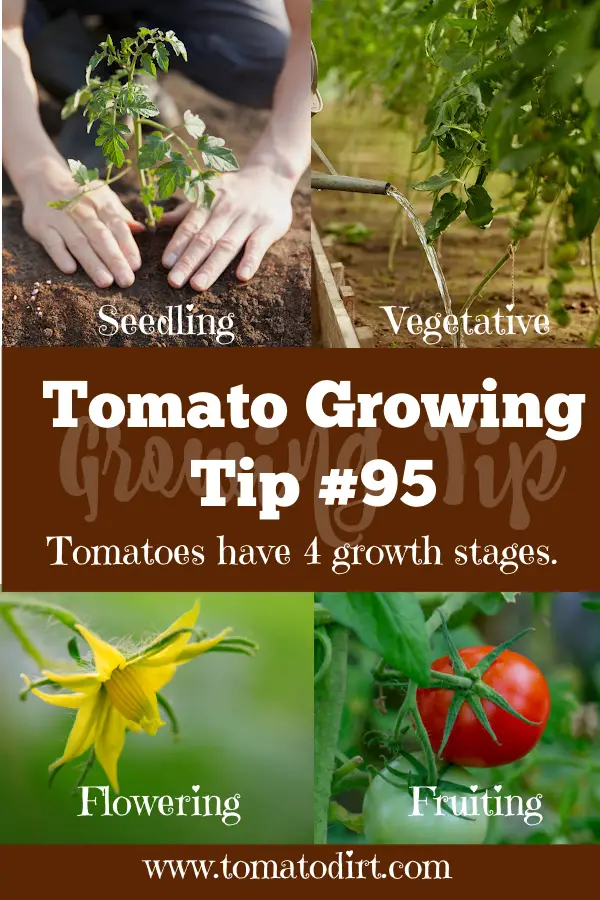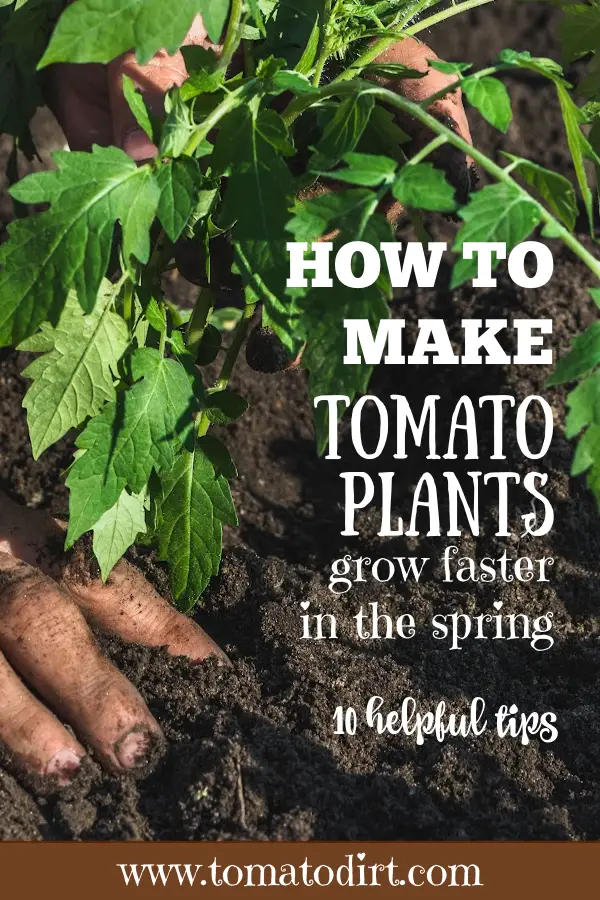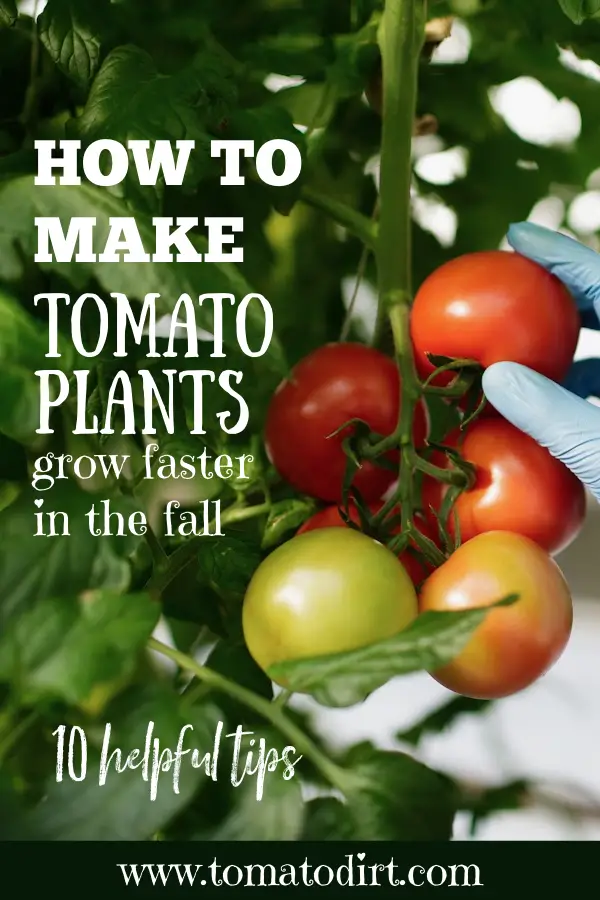FREE: 10 Must-Know Tomato Growing Tips Get The Guide
Read our affiliate disclosure here.
How To Make Tomato Plants Grow Faster
Since 2010, Tomato Dirt has garnered 4.8+ million views, making it the web’s leading online source for growing tomatoes in the home garden. Award-winning writer and Tomato Dirt owner Kathy Widenhouse has helped thousands of home gardeners grow healthier tomatoes. Be one of them when you get Tomato Dirt’s Growing Guide here.
Updated 5.24.25
How can you make tomato plants grow faster?
It’s a question that we face in the spring, when our healthy seedlings are in the ground and we’re anxious to bite into that first juicy tomato. By the time you get to mid-season, it’s not much of an issue. Your tomato plants are chugging along quite nicely.
But the weeks fly by and soon we’re at the end of the season. What helps tomato plants grow faster when they’re nearly done with their lives? We want our plants to finish strong so we can get as much fresh fruit as possible before frost knocks out our whole crop.
Understand tomato growth stages
Tomato plants go through four distinct growth stages. When you understand those stages, you can know how to move your plants along faster both at the beginning of the season and at the end.
- Seedling. Your tomato plant emerges from the seed and develops its first true leaves.
- Vegetation. During this stage, the plant focuses on leaf and stem development.
- Flowering. Tomato blossoms appear, which signals the beginning of fruit formation.
- Fruiting. Tomatoes grow and ripen.
How to make tomato plants grow faster in the spring
Most of us want to get our tomato plants in the ground as soon as we can at the beginning of a new season. We’ve been patient all winter long. How can you make tomato plants grow faster?
But beyond an early-as-possible planting date, consider how to move things along when tomato plants in in the ground. With a head start, you can start enjoying homegrown tomatoes sooner. Plus, there’s opportunity for a bigger yield.
- When tomato plants grow faster, they often produce more fruit over the growing season. This is because they have more time to mature and produce multiple sets of flowers and fruit clusters.
- Further, tomato plants that grow quickly can outpace certain pests and diseases. For example, faster growth may help plants avoid the worst effects of early blight or pest infestations that are more common later in the season.
- Even better: if your tomato plants grow quickly and are harvested early, you can use the space for a second crop of tomatoes or another vegetable later in the season. This practice, known as succession planting, maximizes your garden’s productivity.
Naturally, there are fundamental tips to follow when you plant tomatoes to maximize their growth early in the season. Harden off seedlings before you set them into the ground. And protect your new tomato plants from late frosts and provide warmth (above 50°F even at night) for optimal growth, ensuring they get at least 6-8 hours of direct sunlight daily. Keep soil consistently moist but not waterlogged. Remove lower leaves to improve air circulation and support the main stem with stakes or cages as the plant grows.
Beyond those basics, you can move your plants through the vegetation and flowering stages so they get to fruiting and ripen up quickly. Try these 10 special tips before you even plant – and immediately after – that explain how to make tomato plants grow faster in the spring.
1. Warm the soil with black plastic
Tomato plants thrive in warm soil, but spring temperatures can still be cool. Warming the soil encourages faster root development. Cover the planting area with black plastic a few weeks before planting to absorb heat from the sun. This will raise the soil temperature and give your tomato seedlings a head start.
2. Pre-sprout seeds indoors
Pre-sprouting seeds gives them a head start and ensures only the strongest, fastest-growing seeds are planted. Place seeds between damp paper towels and keep them in a warm, dark place. Once they sprout, carefully plant them in seed-starting mix.
3. Use trench planting for stronger root growth
Trench planting allows tomato plants to develop additional roots along the buried stem, leading to stronger plants with better access to water and nutrients. Lay the tomato plant sideways in a trench. Bury most of the stem and leave only the top few inches above ground. The buried stem will sprout roots, creating a more robust root system.
4. Use companion planting
Certain plants like basil not only repel pests from tomatoes and also improve soil quality, making nutrients more available to tomato plants. They're known as "companion plants." Along with basil, marigolds and nasturtiums are tomatoes’ BFFs. Plant them alongside your tomatoes to improve growth and deter pests. The aromatic compounds released by these plants can also stimulate tomato growth.
5. Add Epsom salts
Epsom salt is rich in magnesium, which is essential for photosynthesis and helps the plant absorb other nutrients, especially phosphorus. Mix one tablespoon of Epsom salt in a gallon of water and use it to water your tomato plants once a month. Alternatively, sprinkle a tablespoon of Epsom salt around the base of each plant when you first plant them.
6. Incorporate fish emulsion
Fish emulsion is a quick-release organic fertilizer that is high in nitrogen, promoting leafy growth and helping plants establish faster. Apply fish emulsion as a foliar spray or soil drench once every two weeks. Be sure to follow the dilution instructions to avoid burning the plants.
7. Pinch off early flowers
As hard as it may be, nip the first set of tomato blossoms on your plants. You’ll redirect the plant's energy into establishing strong roots and foliage. More vigorous growth now means a larger yield later.
8. Make friends with good fungi
Not all fungi are helpful for tomato plants. (Early blight, late blight, and Septoria leaf are a few bullies that come to mind.) But mycorrhizal fungi are the good guys. They form symbiotic relationships with plant roots, extending their reach for water and nutrients, which can accelerate growth.
When you plant your tomatoes, dust the roots with a mycorrhizal inoculant or mix it into the planting hole. You’ll help plants boosts their nutrient uptake, especially phosphorus – crucial for root and flower development.
9. Add calcium
Calcium is essential for cell wall development. It helps prevent issues like blossom end rot, which is especially prevalent in the early season. Plus, calcium promotes stronger, faster-growing plants. Crush eggshells and mix them into the soil at the base of the plant. Or use a calcium-rich amendment like gypsum when planting your tomatoes.
10. Feed leaves with seaweed
Seaweed extract is rich in micronutrients, hormones, and enzymes that promote faster and more robust growth. Apply seaweed extract as a foliar spray once a week in the early morning or late evening when temperatures are cooler.
How to make tomato plants grow faster in the fall
When it gets near the end of the season, daylight hours decrease and temperatures cool. Plants prioritize energy toward ripening existing fruit rather than producing new growth.
Who doesn’t want to eke out as many fresh tomatoes as possible before winter sets in?
Clearly, at this point you are way beyond seedling stage – even the vegetation stage. There’s still some room for blossoming. But you definitely want to accelerate your tomato plants’ fruiting stage so you can accumulate more fruit for eating fresh and extras for freezing, canning, or drying. And what about those green tomatoes that are already on the vine? If you urge them along, they develop more interior sugars and taste better than when green tomatoes ripen indoors.
Plus when you help tomatoes grow faster at season end, you protect plants from an early frost, which can damage or kill plants. You can complete your harvesting and garden clean-up earlier, which reduces the amount of work needed as the season transitions to winter – like planting cover crop or adding refuse to the compost pile before snow comes.
Here are 10 special tips that explain how to make tomato plants grow faster in the fall.
1. Extend daylight
As daylight hours shorten in the fall, tomato plants receive less light, which can slow their growth. Supplement natural light with grow lights to extend the growing period. Set up grow lights to provide additional light in the early morning or evening. Use an extension cord from your power source to your garden. LED grow lights are energy-efficient and can be adjusted to mimic the sun’s spectrum, promoting faster growth.
2. Use row covers or tunnels for warmth
Fall temperatures can drop quickly, which slows the growth of tomato plants. Row covers or low tunnels trap heat and protect plants from cold snaps. Install row covers or tunnels over your tomato plants, especially during chilly nights. This creates a mini greenhouse effect, maintaining a warmer microclimate for the plants.
3. Focus on fast-maturing varieties
Planting a fall or second season crop of tomatoes? Choose fast-maturing tomatoes like determinates or bush varieties so that plants produce fruit before the first frost. Good examples are Early Girl and Stupice. These varieties complete their life cycle faster – often in 60 days or less – so you can harvest before cold weather sets in.
4. Mulch heavily so soil stays warm
Mulching helps insulate the soil, allowing it to retain heat and moisture. Both are crucial for your tomato plants’ survival as temperatures drop in the fall. As summer wanes, apply a thick layer (3-4 inches) of organic mulch, like straw or shredded leaves, around the base of the plants. By taking this step you do double duty. You give their roots a warm environment. Plus, you reduce the risk of diseases by keeping soil-borne pathogens from splashing onto plant leaves.
5. Spray leaves with potassium
Potassium is essential for fruit development. Ample potassium can help speed up the ripening process as the growing season winds down. During the late season, apply a potassium-rich foliar spray (like a kelp extract) directly to the leaves of your tomato plants. By spraying, you ensure that nutrients are absorbed quickly. That means faster fruiting and ripening.
6. Prune aggressively
As the season ends, sharpen your garden shears. Then, prune excess foliage and suckers on your tomato plants. Remove any new flower clusters. Doing so redirects the plant’s energy towards helping the existing fruit to ripen instead of producing new growth.
7. Use a cold frame
A cold frame is like a mini greenhouse that captures and retains heat, extending the growing season by a few weeks. You can place a cold frame over your tomato plants as temperatures start to drop. This provides a controlled environment where the soil stays warm, and the plants are protected from frost, encouraging continued growth.
8. Apply phosphorus
Phosphorus is critical for root development and flower formation. When conditions are cooler – as is the case in early season – a dose of phosphorus can help speed up the growth and ripening process. Add a phosphorus-rich fertilizer or bone meal to the soil around your tomato plants to promote strong roots and ensure that the plant can sustain growth even as the weather cools.
9. Cover plants overnight
Frost can severely damage tomato plants in the fall, slowing down growth or even killing the plant. Frost blankets – whether they’re simply sheets, towels, blankets, or special garden coverings – provide insulation and protect plants from cold temperatures. Drape frost blankets over your plants in the evening when temperatures are expected to drop. Remove the covers during the day to allow sunlight and warmth to reach the plants.
10. Harvest green tomatoes
If frost is imminent and you have unripe tomatoes, you can still save the remainder of your crop. Pick any tomatoes that remain on the vine, no matter what stage they are in ripening. Place them in a warm, dry area indoors, or wrap them individually in newspaper. The ethylene gas produced by the tomatoes will help them ripen off the vine.
Make tomatoes grow faster with just a bit of TLC
But don’t be overwhelmed by all the options that show you how to make tomato plants grow faster, whether it's in the spring or the fall.
Just choose one or two of these tips and put them into practice.
It doesn’t take much effort, and the payoff is big. You’ll help your tomato plants grow faster, you'll harvest more fruit, and you'll have a healthier garden.
More on ripening tomatoes and harvesting them
Harvesting tomatoes: when to pick them ...
How Do You Ripen Tomatoes on the Vine Faster?
The 6 Tomato Growing Stages Explained ...
How to Increase Flowering in Tomatoes ...
Tips for Topping a Tomato Plant to Extend Harvest ...
10 tips for ripening tomatoes on the vine ...
What To Do with Green Tomatoes at the End of the Season ...
How to extend harvest of homegrown tomatoes ...
Get more tips on our Harvesting Tomatoes Pinterest board.
Return from How To Make Tomato Plants Grow Faster to Tomato Dirt home
As an Amazon Associate and Rakuten Advertising affiliate I earn from qualifying purchases.
SHARE THIS PAGE:
FREE! 10 Must-Know Tomato Growing Tips: 20-page guide
Get yours here:










